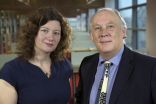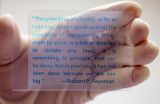Nanotubes may restore sight to blind retinas
Tel Aviv University researchers develop groundbreaking wireless material capable of sparking neuronal activity in response to light
2014-12-02
(Press-News.org) The aging process affects everything from cardiovascular function to memory to sexuality. Most worrisome for many, however, is the potential loss of eyesight due to retinal degeneration.
New progress towards a prosthetic retina could help alleviate conditions that result from problems with this vital part of the eye. An encouraging new study published in Nano Letters describes a revolutionary novel device, tested on animal-derived retinal models, that has the potential to treat a number of eye diseases. The proof-of-concept artificial retina was developed by an international team led by Prof. Yael Hanein of Tel Aviv University's School of Electrical Engineering and head of TAU's Center for Nanoscience and Nanotechnology and including researchers from TAU, the Hebrew University of Jerusalem, and Newcastle University.
"Compared to the technologies tested in the past, this new device is more efficient, more flexible, and can stimulate neurons more effectively," said Prof. Hanein. "The new prosthetic is compact, unlike previous designs that used wires or metals while attempting to sense light. Additionally, the new material is capable of higher spatial resolution, whereas older designs struggled in this area."
A natural shape
The researchers combined semiconductor nanorods and carbon nanotubes to create a wireless, light-sensitive, flexible film that could potentially replace a damaged retina. The researchers tested the new device with chick retinas which were not yet light sensitive to prove that the artificial retina is able to induce neuronal activity in response to light.
Patients with age-related macular degeneration (AMD), which usually affects people age 60 or older who have damage to a specific part of the retina, will stand to benefit from the nanotube device if it is proved compatible in animals over the long term.
According to TAU doctoral student and research team member Dr. Lilach Bareket, there are already medical devices that attempt to treat visual impairment by sending sensory signals to the brain. While scientists are trying different approaches to develop an implant that can "see" light and send visual signals to a person's brain, to counter the effects of AMD and related vision disorders, many of these approaches require the use of metallic parts and cumbersome wiring or result in low resolution images. The researchers set out to make a more compact device.
Progress in the right direction
"In comparison with other technologies, our new material is more durable, flexible, and efficient, as well as better able to stimulate neurons," said Prof. Hanein. "We hope our carbon nanotube and semiconductor nanorod film will serve as a compact replacement for damaged retinas."
"We are still far away from actually replacing the damaged retina," said Dr. Bareket. "But we have now demonstrated that this new material stimulates neurons efficiently and wirelessly with light. If you compare this to other devices based on silicon technology, which require wiring to outside energy or light sources, this is a groundbreaking new direction."
The research team received funding for their study from the Israel Ministry of Science and Technology, the European Research Council, and the Biotechnology and Biological Sciences Research Council.
INFORMATION:
American Friends of Tel Aviv University supports Israel's most influential, most comprehensive and most sought-after center of higher learning, Tel Aviv University (TAU). US News & World Report's Best Global Universities Rankings rate TAU as #148 in the world, and the Times Higher Education World University Rankings rank TAU Israel's top university. It is one of a handful of elite international universities rated as the best producers of successful startups, and TAU alumni rank ninth in the world for the amount of American venture capital they attract.
A leader in the pan-disciplinary approach to education, TAU is internationally recognized for the scope and groundbreaking nature of its research and scholarship -- attracting world-class faculty and consistently producing cutting-edge work with profound implications for the future.
ELSE PRESS RELEASES FROM THIS DATE:
2014-12-02
Researchers at the University of Illinois at Urbana-Champaign have figured out how to reverse the characteristics of a key bonding material--polyurea--providing an inexpensive alternative for a broad number of applications, such as drug delivery, tissue engineering, and packaging.
"Polymers with transient stability in aqueous solution, also known as hydrolysable polymers, have been applied in many biomedical applications, such as in the design of drug delivery systems, scaffolds for tissue regeneration, surgical sutures, and transient medical devices and implants," ...
2014-12-02
Some of the most elaborately decorated instruments in history were produced in 18th century Naples. The materials for varnishes and decorations used by individual mandolin masters, honed for wealthy clients in the ancient city's labyrinthine artisan quarter, have been kept secret for over 200 years. Details are disclosed for the first time by Tommaso Rovetta from the Università degli Studi di Pavia and colleagues at the Laboratorio Arvedi Research Group in Springer's journal Applied Physics A - Materials Science & Processing.
Italian conservation scientists studied ...
2014-12-02
Philadelphia, PA, December 2, 2014 - Few classes of drugs have had such a transformative effect on the prevention of cardiovascular disease (CVD) as have statins, prescribed to reduce total cholesterol and low-density lipoprotein cholesterol. However, some clinicians have ongoing concerns regarding the potential for lens opacities (cataracts) as a result of statin use. In an article in the Canadian Journal of Cardiology, researchers report increased risk for cataracts in patients treated with statins. An accompanying editorial discusses the history of statins and positions ...
2014-12-02
SALT LAKE CITY, Utah, Dec. 2, 2014 - Myriad Genetics, Inc. (NASDAQ: MYGN) today announced that clinical data from three studies with Prolaris in prostate cancer patients will be highlighted at the 2014 Society of Urologic Oncology (SUO) Annual Meeting being held tomorrow in Rockville, Md. The new data show that the Prolaris test could save the healthcare system $6 billion over 10 years and that physicians are using the test appropriately to personalize treatment options for their patients.
"Improving patient care is our highest priority, and we strive to prevent the ...
2014-12-02
With the help of citizen scientists, a team of astronomers has found an important new example of a very rare type of galaxy that may yield valuable insight on how galaxies developed in the early Universe. The new discovery technique promises to give astronomers many more examples of this important and mysterious type of galaxy.
The galaxy they studied, named J1649+2635, nearly 800 million light-years from Earth, is a spiral galaxy, like our own Milky Way, but with prominent "jets" of subatomic particles propelled outward from its core at nearly the speed of light. The ...
2014-12-02
CAMBRIDGE, MA -- Today's atmosphere likely bears little trace of its primordial self: Geochemical evidence suggests that Earth's atmosphere may have been completely obliterated at least twice since its formation more than 4 billion years ago. However, it's unclear what interplanetary forces could have driven such a dramatic loss.
Now researchers at MIT, Hebrew University, and Caltech have landed on a likely scenario: A relentless blitz of small space rocks, or planetesimals, may have bombarded Earth around the time the moon was formed, kicking up clouds of gas with enough ...
2014-12-02
This news release is available in French. Montreal, December 2, 2014 -- "Selfish" may be the adjective most often attached to millennials. But new research from Concordia University shows that the young men and women who make up the millennial generation aren't so self-centred when it comes to supporting charities -- as long as marketers use the right tactics for each gender.
The forthcoming study in The Journal of Nonprofit & Public Sector Marketing confirms stereotypes and reveals an important paradox. When asked to support charitable causes, millennials -- those ...
2014-12-02
INDIANAPOLIS -- Researchers from the Regenstrief Institute and the Indiana University Center for Aging Research report that waking intensive care unit patients and having them breathe on their own decreased both sedation levels and coma prevalence. The Wake Up and Breathe program also showed a trend toward reduced delirium in a critically ill population.
Participants in the study, which is published in the December 2014 issue of the peer-reviewed journal Critical Care Medicine, were 702 Eskenazi Health ICU patients 18 and older. Results were achieved without a change ...
2014-12-02
International research led by the University of Leicester published in Nature Communications reveals:
Analysis of all the available evidence confirms identity of King Richard III to the point of 99.999% (at its most conservative).
Analysis of the mitochondrial DNA shows a match between Richard III and modern female-line relatives, Michael Ibsen and Wendy Duldig.
The male line of descent is broken at one or more points in the line between Richard III and living male-line relatives descended from Henry Somerset, 5th Duke of Beaufort.
King Richard was almost certainly ...
2014-12-02
RIVERSIDE, Calif. - First developed in China in about the year A.D. 150, paper has many uses, the most common being for writing and printing upon. Indeed, the development and spread of civilization owes much to paper's use as writing material.
According to some surveys, 90 percent of all information in businesses today is retained on paper, even though the bulk of this printed paper is discarded after just one-time use.
Such waste of paper (and ink cartridges)--not to mention the accompanying environmental problems such as deforestation and chemical pollution to air, ...
LAST 30 PRESS RELEASES:
[Press-News.org] Nanotubes may restore sight to blind retinas
Tel Aviv University researchers develop groundbreaking wireless material capable of sparking neuronal activity in response to light



